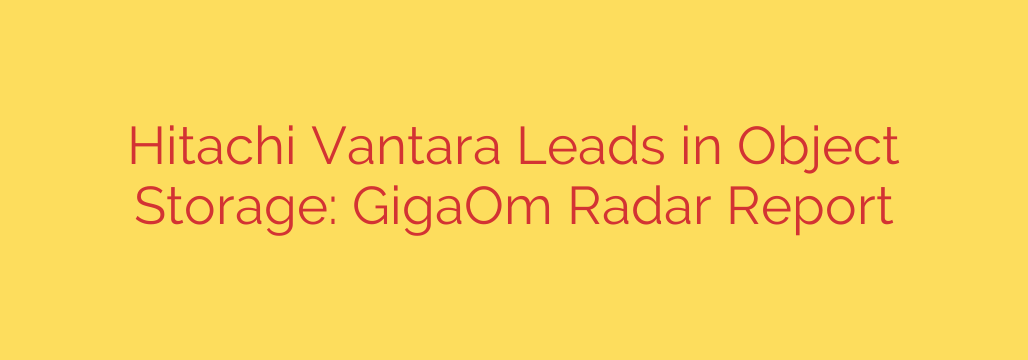
Navigating the Data Deluge: What Defines a Leader in Object Storage?
In today’s digital-first world, organizations are grappling with an unprecedented explosion of data. From customer information and IoT sensor logs to high-resolution media and AI training sets, unstructured data is growing at a staggering rate. Traditional storage systems are buckling under the pressure, proving too costly, rigid, and complex to manage this new reality.
This is where object storage comes in. Designed for massive scalability and cost-efficiency, object storage has become the go-to solution for modern enterprises. But not all platforms are created equal. Recent independent industry analysis highlights a clear separation between standard offerings and true market leaders. Understanding what defines a top-tier solution is crucial for any organization looking to build a future-proof data strategy.
Hallmarks of a Premier Object Storage Platform
When evaluating object storage solutions, the best platforms distinguish themselves across several critical areas. These are not just features on a checklist; they are foundational pillars that determine performance, security, and long-term value.
1. Exceptional Performance at Scale
Modern workloads demand more than just capacity. They require high-speed data ingestion and retrieval to power real-time analytics, AI/ML model training, and content delivery.
A leading solution must deliver balanced performance for both small and large objects, ensuring that applications don’t suffer from bottlenecks. This means optimized metadata handling and a distributed architecture that can process billions of objects without degradation. The ability to maintain high throughput and low latency, even as the system grows, is a key differentiator.
2. Unparalleled Scalability and Reliability
The primary promise of object storage is its ability to scale. A premier platform is architected for virtually limitless growth.
Look for solutions that can scale seamlessly from terabytes to exabytes within a single, unified namespace. This eliminates the need for disruptive data migrations and complex management of separate storage silos. Furthermore, best-in-class reliability, achieved through robust data protection schemes and self-healing capabilities, ensures your data remains available and intact with enterprise-grade durability.
3. Superior Total Cost of Ownership (TCO)
The initial purchase price is only one part of the equation. The true value of a storage solution is measured by its Total Cost of Ownership (TCO). Leading platforms are engineered for efficiency, helping to significantly lower operational expenses over time.
This is achieved through:
- High-density configurations that reduce data center footprint.
- Intelligent data placement and lifecycle management to optimize storage tiers.
- Simplified, automated administration that frees up valuable IT resources.
4. Robust, Metadata-Driven Security
In an era of constant cyber threats, security cannot be an afterthought. Top-tier object storage platforms integrate security into their very core.
A leading platform offers comprehensive, metadata-driven security policies that can be customized for specific data types and compliance requirements. This includes features like fine-grained access controls, robust encryption for data in-flight and at-rest, and support for Write-Once-Read-Many (WORM) immutability to protect against ransomware and accidental deletion.
5. Seamless Hybrid and Multi-Cloud Integration
The modern enterprise operates in a hybrid world. Your data needs to be accessible where your applications are, whether that’s in your data center, at the edge, or across multiple public clouds. The best object storage solutions provide a single, consistent experience across all environments. They achieve this with native support for the Amazon S3 API, enabling seamless application portability and eliminating cloud vendor lock-in.
Key Applications Driving Modern Object Storage Adoption
The versatility of leading object storage platforms makes them ideal for a wide range of mission-critical use cases:
- Artificial Intelligence (AI) and Analytics: Providing a massive, high-performance data lake to feed demanding analytics engines and AI/ML pipelines.
- Cloud-Native Application Development: Offering persistent, S3-compatible storage for containerized applications built on platforms like Kubernetes.
- Backup, Archive, and Ransomware Recovery: Delivering a secure, cost-effective, and immutable repository for protecting critical business data.
- High-Performance Computing (HPC): Managing the enormous datasets generated by scientific research, financial modeling, and engineering simulations.
Actionable Security Tips for Your Object Storage
To maximize the security of your data, consider implementing these best practices:
- Enable Object Immutability: Use WORM or object-lock features to create immutable copies of your critical backups, making them invulnerable to ransomware encryption.
- Enforce the Principle of Least Privilege: Utilize identity and access management (IAM) roles to ensure users and applications only have the permissions they absolutely need.
- Encrypt Everything: While encryption at-rest is standard, ensure you are also encrypting data in-transit to protect it as it moves across the network.
- Audit Access Regularly: Consistently monitor access logs to detect unusual activity or potential security vulnerabilities before they can be exploited.
Choosing an object storage solution is a long-term strategic decision. By focusing on platforms that demonstrate clear leadership in performance, scalability, security, and cost-efficiency, you can build a resilient data foundation that will support your organization’s growth and innovation for years to come.
Source: https://datacenternews.asia/story/hitachi-vantara-named-leader-for-object-storage-by-gigaom-radar








